Although once used only by professional lumberjacks, chain saws are now popular among many homeowners and farmers. Homeowners use them to cut firewood and to do general tree trimming around their homes. Farmers find them very useful for such jobs as clearing land, trimming trees and cutting firewood.
However, in the hands of a careless or inexperienced operator, chain saws can be very hazardous. The U.S. Consumer Product Safety Commission estimates that in 1979 approximately 50,000 people required hospital treatment for injuries associated with chain saws. Most accidents were caused by the operator coming into contact with a moving chain saw blade. Injuries from a chain saw are usually serious because they leave a jagged cut.
| Table 1. Selecting a Chain Saw. | ||
| Type | Guide bar length | Use |
|---|---|---|
| Mini or lightweight saws | 8 to 12 inches | Light and occasional use for limbing, cutting small logs and felling very small trees. |
| Midweight saws | 14 to 20 inches | Frequent log cutting and felling of small trees. |
| Heavyweight saws | Over 20 inches | Professional use, not generally recommended for consumers. |
First, you must decide whether a gasoline or electric chain saw is best for you. Consider the following points when selecting a saw.
Electric-powered saws (Should be listed by the Underwriters' Laboratories (UL)):
Gasoline-powered saws:
Second, consider the length of the guide bar. Match the bar size to the type of job you expect to do most often.
Mini or lightweight saws have 8- to 12-inch guide bars; they are for light and occasional use for limbing, cutting small logs and felling very small trees.
Midweight saws have 14- to 20-inch guide bars; they can be used for frequent log cutting and felling of small trees.
Heavyweight saws have guide bars that are more than 20 inches long. These saws are not generally recommended for non-professional saw owners.
If the guide bar is substantially longer than the thickness of the wood to be cut, accidental contact between the guide bar tip and a branch, the ground or other object could result in a serious kickback injury.
If the guide bar is too short, you will have to bury the tip of the guide bar in the cut. Although most manufacturers indicate that a saw can cut a log twice as thick as the guide bar, burying the tip of the guide bar in the wood could also result in a serious kickback injury.
YOU AND YOUR SAW
Before you cut firewood or timber, outfit yourself with the proper clothing and personal protective equipment that will help reduce the possibility of a serious injury. Use the following list as a guide.
PREPARE THE SAW
A properly sharpened chain. If you notice that the chain tends to walk sideways while cutting or the cut shows fine powder instead of chips, or if you find yourself pressing down hard to keep cutting or smell burnt wood, your saw needs sharpening.
Follow the instructions outlined in your owner's manual when sharpening the chain. If you do your own sharpening, use the proper tools. Wear gloves or use a rag over the chain to protect your hands from the sharpened cutters.
Correct chain tension. To assure good cutting action and a long chain life, check chain tension. If too loose, a chain will derail; if too tight, a chain will bind.
All chains stretch with use. Most of the stretch occurs during the first half hour of operation. Follow the manufacturer's recommendation on chain tension. Most manufacturers recommend that a cold chain be tightened to where the chain tie straps hang away from the bar rail about 1/32 of an inch at the center of the bar. A warm chain should be adjusted to a 1/8-inch gap.
Proper lubrication. Lubrication will prolong a chain's useful life. On saws with automatic oilers, be sure the oiler is properly adjusted so it doesn't over-oil and run dry during operation. Remember that automatic oilers need an extra squirt of oil occasionally.
Occasionally the bar-oiling mechanism plugs up; serious damage to the saw can result if this is not corrected. If the chain smokes while operating, there is not enough lubrication. To check for bar oiling, hold the saw tip above a light colored, dry surface and accelerate the engine. Oil should spatter on the surface if the oiler is operating properly. If not, remove the guide bar and check the chain oil discharge slot.
Tool kit. Every owner should have a good tool kit to help ensure continued operation of the saw. The kit should contain the following:
OPERATING TECHNIQUES
Only refuel the engine when it is cool.
If fuel is spilled, thoroughly clean the engine with the saw on the ground and in an area cleared of combustible materials.
Do not smoke during refueling.
Each time you refuel, check the refill oiler, air filter, chain tension and the tightness of all nuts, bolts and screws.
Starting the engine. With one foot placed in the bracket to the rear of the unit, start the saw engine on level ground. Set the starting controls. Grip the top handle of the saw firmly with one hand; use your other hand to pull the starting rope. Smaller saws may not have a foot bracket, so make certain the saw is held firmly on the ground. Never drop start the saw.
Felling procedures. Before you attempt to fell any tree, consider its characteristics. One tree may lean, and another tree might be unbalanced because of uneven top growth or breakage even though the trunk doesn't lean. Large diameter branches are also a good indicator of imbalance. Also consider wind conditions, which can have a dramatic effect on the direction of fall.
 Clear the ground. Before you start to cut, clear the
ground around the base of the tree of low or dead limbs, underbrush
and other obstructions. This precaution should provide clear
vision, unrestricted movement and an unhampered escape route
when the tree begins to fall (Figure 1).
Clear the ground. Before you start to cut, clear the
ground around the base of the tree of low or dead limbs, underbrush
and other obstructions. This precaution should provide clear
vision, unrestricted movement and an unhampered escape route
when the tree begins to fall (Figure 1).
A felling and safety plan. In advance, plan your escape route to either the rear or side, depending on the likely direction of the fall. When the tree starts to go, shut the saw off and drop it in a place that will allow an unhampered escape.
When you have determined a felling and safety plan, proceed as follows:
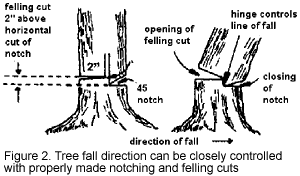
Wedges. A well-balanced tree may have to be wedged, pulled or pushed to fall in a desired direction. Wedges are the most dependable means of controlling the direction a tree will fall.
Use two wedges rather than one to insure that the tree falls forward. Use a sledge or mallet with a face at least 1/3 larger than the breadth of the wedge. Strike squarely with firm, but not excessive, blows. Careless blows may pop the wedge out, swinging the tree backward. Using an ax head as a wedge or driver is dangerous. The steel is likely to splinter, and flying particles might strike the user.
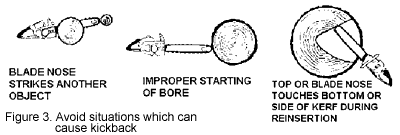
LIMBING
After the tree is on the ground, take a look at each limb before making the cut to be sure that cutting the limb off will not bind the guide bar or cause the trunk to roll toward the operator.
Do not face the limb squarely. Stand at a 45-degree angle so that if the saw slips or completes the cut sooner than expected, the chain will not strike your leg.
Sawing with the point of the guide bar (nose sawing) greatly increases the chances of chain saw kickback (Figure 3). If the chain suddenly hits a solid object or takes too large of a cut, then the saw may be forced backward. This could result in a serious accident.
Preventing kickback. Follow these steps to prevent kickback:
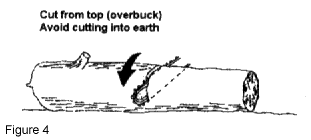 |
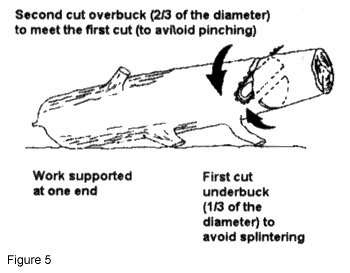 |
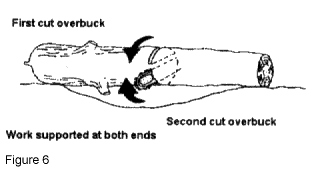 |
While limbing or cutting the trunk (bucking), make sure the chain does not hit the ground. An operator can cut 40 trees and not damage the chain the way striking the ground one time can.
BUCKING (CUTTING THE TRUNK)
If the log is supported on one end, make the first cut from the underside 1/3 the diameter of the log (underbuck). Then complete the cut from the topside (overbuck) (Figure 5).
When the log is supported from both ends, cut 1/3 the diameter from the top (overbuck) then complete the cut by cutting upward from the underside (underbuck) to meet the first cut (Figure 6).
Whenever the saw is being operated, keep people well out of the cutting area. If a person is assisting by removing limbs, be aware of your assistant's position and activity at all times.
When cutting logs with a large diameter, operate the saw with the throttle about three-quarters open. Overpowering the saw will waste fuel and create unnecessary wear. Under-powering will not push enough air through the cooling fins and may cause engine overheating. A saw buck is a handy device for safely cutting wood to the proper length. You can find plans in your owner's manual or at your local library.
ELECTRICALLY POWERED CHAIN SAW SAFETY
The soil in the work area should be relatively dry. Avoid working in areas where foliage or the ground is wet.
Lay out the cord so it will not interfere with your work. Take care to place it so that you don't inadvertently cut it with the saw or trip on it.
Make sure the saw switch is in the "off" position before completing the electrical connection. Always unplug the power before making adjustments and when the saw is not in use.
TRANSPORT AND STORAGE
For storage, drain the fuel tank in a safe area. Run the engine at idle until it stops to remove the remaining gas from the engine. Remove the chain and store it in a container of oil. Disconnect the spark plug wire to reduce the possibility of accidental starting. Store the saw out of reach of children.
FEATURES FOR CONVENIENCE AND SAFE USE
Hand guard. This is a bar in front of the forward handle that keeps the left hand from slipping onto the chain.
Chain brake (Gasoline only). This feature is designed to stop the chain in a fraction of a second if a kickback occurs, thus reducing the chances of serious injury. A chain brake can also serve as hand guard.
Spark arrester (Gasoline only). A spark arrester keeps sparks from being ejected by the exhaust. It is required in some areas of the country.
Safety tip. A safety tip covers the chain as it passes around the nose of the guide bar. It reduces the chance of kickback by keeping the chain from contacting anything at the guide bar tip.
Trigger or throttle lockout. This feature guards against inadvertent saw chain motion.
Chain catcher. A chain catcher helps with electrical safety. If you choose an electric chain saw, select one that has been UL listed.
Vibration reduction system. Rubber bushings between the handle and saw body or on the engine mountings help reduce the vibration you feel when sawing. This reduces fatigue.
Bumper spikes. Most saws have large spikes on the front of the engine or motor housing that grip the wood and help hold the saw in place during cutting.
Automatic chain oiling. This feature automatically oils the chain.
Automatic chain sharpening. This helps keep the chain sharp while on the job. Manual sharpening should still be performed every three to four hours of use. Excessive use causes chain wear.
Compression release (Gasoline only). This makes starting large engines much easier.
Case and/or chain sheath. This protects the saw from dirt during storage and transfer.
Adjustment tool. This is a tool with the proper wrench sizes for adjusting the chain and removing spark plugs.
| Table 2. Chain saw troubleshooting guide. | ||
| Symptom | Problem | Correction |
|---|---|---|
| Difficult or poor cutting | Chain dull | Sharpen chain |
| Improperly sharpened chain | Check chain | |
| Chain installed backward | Turn chain around | |
| Improper chain tension | Correct chain tension | |
| Bar and chain aren't being lubed | Fill oil tank, adjust oiler | |
| Damaged guide bar | Inspect guide bar | |
| Exhaust ports dirty | Clean muffler and exhaust ports | |
| Fuel filter dirty | Clean fuel filter | |
| Improperly adjusted carburetor | Adjust carburetor | |
| Oiler not working | Out of oil | Fill oil tank |
| Oil hole plugged | Clean oil supply hole | |
| Oil strainer dirty | Clean oil strainer | |
| Oiler adjusted incorrectly | Adjust oiler | |
| Plugged vent on oil tank cap | Clean vent on oil tank cap | |
| Engine won't start | Improper starting procedure | Follow correct procedure |
| Fuel tank empty | Fill fuel tank | |
| Engine flooded | Clean spark plug | |
| Carburetor adjustment incorrect | Adjust carburetor | |
| Spark plug fouled | Clean or replace plug | |
| Engine dies or accelerates poorly | Fuel tank empty | Fill fuel tank |
| Air cleaner dirty | Clean air cleaner | |
| Spark plug fouled | Clean or replace plug | |
| Carburetor adjustment incorrect | Adjust carburetor | |
| Plugged vent on fuel tank cap | Clean vent on fuel tank cap | |
Publication #: GO1959
This document is apart of a series from the University Extension, the University of Missouri-Columbia, Columbia, MO 65211. Publication date: October 1993.
David E. Baker, Department of Agricultural Engineering, and Don Day, Area Agricultural Engineering Specialist, University of Missouri-Columbia, Columbia, MO 65211.
Disclaimer and Reproduction Information: Information in NASD does not represent NIOSH policy. Information included in NASD appears by permission of the author and/or copyright holder. More